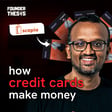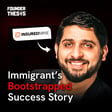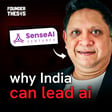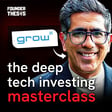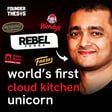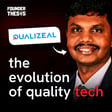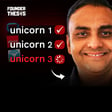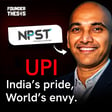Introduction to Founder Thesis Podcast
00:00:01
Speaker
Take a minute, I'm dead, you know what I'm talking about. This is Aurabh and you are listening to the Founder Thesis Podcast. We meet some of the most celebrated sort of founders in the country. And we want to learn how to build a unicorn.
Ram's Journey and Hyperface's Vision
00:00:27
Speaker
Hi, this is Ram here. I am founder of Hyperface, which is a fintech company based out of Bangalore. They say that during a gold rush, it's the people selling the shovels who make the most money. Right now in India, there is a sort of a gold rush of BNPL or Buy Now, Pay Later, which is essentially a form of lending.
00:00:47
Speaker
Companies are raising billions of dollars to offer BNPL services to merchants. And this is where a company like Hyperface comes in. Hyperface is building the rails of BNPL. Essentially, they're selling the shovels in the gold rush. And what Hyperface does is it allows any startup to offer BNPL to their customers without worrying about KYC, bank collaborations, credit risk underwriting, and so on.
00:01:16
Speaker
Essentially, offering BNPL is as easy as getting a payment gateway.
Building BNPL Infrastructure
00:01:23
Speaker
Ramanathan Aree or Ram, the founder of Hyperface, is a serial entrepreneur. In his last stint, he was the founder at Jaspay, which was also a payment solutions company, where he was trying to solve the problem of the user experience during payments.
00:01:39
Speaker
Not only that, but he was also the man behind the Bheem app, which was amongst the first UPI apps in India. Listen on to Ram talk about his fascinating journey and get an insider understanding of the fintech space.
Growth of Indian Startups and Venture Capital
00:01:55
Speaker
Once you think about starting out, that thought never leaves you. What happened during that time is that companies like Flipkart had grown. Again, still they hadn't attained unicorn status at that time, but they had become a household name for a lot of people in the country. When the startup ecosystem started thriving, more venture capital money started coming into India.
00:02:19
Speaker
Tiger Global had placed a bet on Flipkart and it seemed like that the moment has arrived for Indian startups.
Focus on Payments and User Experience
00:02:32
Speaker
We were, so this was a time when I, along with Bimal, Bimal and I go way back to Amazon days. We worked together at Bank Bazaar as well. And we were, we were discussing, you know, perhaps this is the time for us to take on a much bigger challenge, go and solve a difficult problem, a practical problem.
00:02:55
Speaker
So, we shortlisted a variety of ideas and we were iterating on those ideas. We were looking at real estate, we were looking at education tech, and then we zeroed in on payments eventually. Okay. And what was the thesis? Like the original problem statement that you were going to solve?
00:03:15
Speaker
Yeah, again, you know, we love to keep things very simple, right? Looking at this philosophy goes back to the Amazon days where the key players, the outcomes are quite simple. Okay.
00:03:31
Speaker
in Amazon, the philosophy is how do I offer the cheapest, how do I offer a product at the cheapest price to the customer, right? And how do I create much wider selection that's possible, right? So, Amazon had this interesting thing called buy with one click checkout,
Lessons from Amazon and Checkout Innovations
00:03:49
Speaker
right? And this really, really added a much better conversion for Amazon.
00:03:55
Speaker
And people looking at that and then seeing, okay, how can we bring that kind of an experience to India? Again, the bet was that e-commerce is going to grow significantly and good payments is almost like water and electricity. A good payments infrastructure is almost like good electricity infrastructure, right, or a logistics infrastructure. It has to work, it has to be fantastic.
00:04:21
Speaker
And what does that mean? When you break down that problem, you can see that the number of steps to complete a payment should be as minimum as possible. Yet at the same time, we cannot sacrifice some security. So how can we try and achieve both? So this was the problem statement that we took upon ourselves. And then we said that, OK, let's work backwards and then figure out what it means. And we landed on what culminated to be just payment.
00:04:50
Speaker
So, was it like a payment gateway service like, say, what Razer pays today? Yeah. So, look, yes and no. We initially thought that we would have to become a payment gateway in order to be able to solve this problem. But we were quite clear on the outcome at that time. We were betting on the technology and experience.
00:05:16
Speaker
We were not betting on the money moving problem. That's a whole different dimension of problem. You've got to account for financial risk and many other factors.
Improving Payment Gateway Experiences
00:05:28
Speaker
Whereas we were really betting on the fact that the factors are going to change and experience will have to be better. So how can we just take that problem and then solve for it?
00:05:41
Speaker
So we initially applied for payment gateway and then we realized that we don't have to be a payment gateway. So what was happening was
00:05:49
Speaker
We would go to a Flipkart and then they would have integrated with an HDFC or an ICSA bank for processing cards. Then we went to HDFC bank and then we said, hey, look, we want to be a payment gateway. So HDFC bank offered the same technology to us. And then we were thinking, OK, this is strange. HDFC is offering the same technology to Flipkart and then same technology to us. We don't get anything special. So then why not use Flipkart's existing account itself?
00:06:19
Speaker
and then process transactions because we anyways don't want to be in the money moving part. So what else is there then if not a payment gateway? You're saying you want to optimize the checkout experience. Isn't that essentially just that payment gateway part of it? Like what else is there?
00:06:37
Speaker
So the responsibility of a payment gateway first and foremost is to process the transaction, make sure that the money is received by them and then they settle it out to the merchants. Everything else is incidental to this. A good checkout experience and a very friction free experience. All of that, these problems are all just incidental to that.
00:07:00
Speaker
But the primary responsibility of the payment gateway is to assure the e-commerce merchants that the money is going to be processed for them. Now, this was one of the things that we took off the table and they said that, look, let us focus on the experience because if you get to solving too many problems, then you can't solve one problem really, really well.
00:07:25
Speaker
I remember even at that time when me and Demel used to brainstorm on this side, he used to even think like,
00:07:33
Speaker
Experience really is dictated by the underlying payment methods. Visa, MasterCard, HDFC, net banking, or a wallet. These are all the payment methods that actually set the rules of the game. We used to think at that time, look, if Visa, MasterCard started in the 60s in India, sorry, in the US at that time, AmeriCard was the first version of the card-based experience.
00:08:01
Speaker
Right? Which is very analogish time at that time. Right? Now, we continue to carry that baggage. And it works. It works fantastically well. No, no, absolutely no doubts about that. But what if, let's say, you know, even Visa Mastercard where to think from scratch today, given all these technological advancements, right? How would they think about building a payment system?
00:08:26
Speaker
And can it have a much better experience? For example, you know what you can even think like things like today that Amazon checkout experience that you have in the stores where you just walk
SDK Development and Mobile Payment Optimization
00:08:41
Speaker
And somewhere the payment gets processed by just your facial recognition and things like that. So you've got multiple other dimensions today, which can be used to process payments. And smart phone is one such dimension, which has become almost universal. I wouldn't say universal, but almost universal.
00:09:02
Speaker
Now, what if, let's say, newer payment methods emerge and can the experience be better? Can we play a role in that? So we used to brainstorm these kinds of things. And so our minds were, we were fully set to solve for the experience problem rather than the money moving problem.
00:09:23
Speaker
So what exactly was the product that you launched? Where did that fit into the customer experience workflow, the checkout workflow?
00:09:33
Speaker
Right. So the first problem that we solve for is that, you know, if you have to do buy with one click, then the cards need to be tokenized and stored on file. This is called card or card on file. Right. And this is what Amazon used to do. And once you do that, then the returning customer, say, you know, you go into Flipkart again, the second time. You don't have to enter your card details.
00:09:59
Speaker
You don't have to enter your card details, right? So you just put in your CDB and then the process from there is the usual rest of the remaining process was just the usual one, right? So this was the first problem that we solved and then we set that look. So like the HDFC payment gateway did not have this ability to remember the card and neither was Flipkart doing it natively within their own app to remember the card.
00:10:22
Speaker
Of course, we didn't solve this problem for Flipkart. They built it in-house. We solved this problem for Redbus. Redbus was our first client. And once we solved this problem, then it took us another year to come up with a much better friction-free experience on mobile as a form factor. So 2014, we started experimenting on Android phones. Android phones were becoming more and more commonplace. And we said, OK, in Android phones, now we have
00:10:51
Speaker
This is a new dimension. Now, how can we redo the experience here? We think the experience here. That's how our SDK was born. Today you see where OTPs get auto-captured and then auto-submitted on 3D secure page. We built the initial prototypes in the year 2014 and then 2015, we went live on that product. This was with Redverse only, this OTP.
00:11:20
Speaker
Yeah, so that doesn't make my trip for the initial clients for this as well. And this product was a runaway hit for just me. Pretty much all top e-commerce companies today use this SDK for automating the experience. Not just that, we also did a lot of micro-optimizations.
00:11:44
Speaker
We named it a browser for that particular reason only. So I don't know if you remember, the Opera browser used to do a lot of client-side optimization. It used to cut down by default, it used to cut down advertisements and flash and all of that so that your browsing experience became much nimbler, much faster. So imagine at that time, you wouldn't believe the login pages of net banking, a lot of banks used to contain advertisements.
00:12:13
Speaker
and a lot of unnecessary elements on the page, making it very heavy. And this is free 4G, right? So there's a lot of 2G customers and 3G customers. And imagine the login page of a bank taking 10 seconds. And it was generally not mobile optimized also. It was not mobile optimized, yes.
00:12:34
Speaker
I remember my Bank of India login had a very small username, password, and a lot of white space on the mobile here. Correct. So we optimized a lot of those things. Imagine an opera for payments. So we actually took apart these pages, and then we said, OK, let's cut down the elements that do not make sense for the customer so that the browsing experience improves. So what used to take 10 seconds now took only two seconds.
00:13:00
Speaker
And this resulted in much better experience for customers and translated to better conversions for our e-com merchants, which is why they love JustPay. And all of this was not easy work. So we had to open accounts with a lot of banks. I remember, I myself opened 10 plus accounts, Vimal also opened 10 plus accounts. Okay. So that you test as a customer the experience? Okay.
00:13:29
Speaker
And SDK also, there were enormous amount of challenges. We really had to push the bar on. What is SDK? You are selling an SDK. What does that mean?
00:13:40
Speaker
Yeah. So in mobile apps, so when you look at an Android app or an iOS app, it's a binary software app that needs to be uploaded to the Play Store. So any component that goes into this Android app or an iOS app from a third party used to be called as SDK. Say, suppose you want to do analytics.
00:14:05
Speaker
Okay, so you will have to download Google Analytics SDK, and then you'll have to embed it into your app, right? So for payments, we provided this SDK, and this can now be linked by a WordPress or a Make Network into their application. So this was something that was hosted on your server, and the app would like make a call and or would redirect the customer to a page that loaded on your server or something or like what is it or were you like selling code directly that they would
00:14:35
Speaker
SDK is a shipped software. So it's almost like your smartphone downloads the app file. So as part of that itself, the SDK also gets embedded. So it's almost like the shipped software of the previous generation of Microsoft Windows. So in the app ecosystem, though, Android and iOS ecosystem.
00:14:58
Speaker
Okay, so like MakeMyTrip would buy that code from you essentially and that code would get added to the MakeMyTrip app. And so this was like a one-time payment plus annual maintenance charge or something like that instead of a part transaction fees.
00:15:14
Speaker
Well, that's a very interesting question. Look, Peter Thiel says that it's not only important to create value, but it's also important to be able to capture value. And what part of value you're capturing and leaving on the table for the other party, so that they also see the benefit. So RSDK always, the most important thing about RSDK is that it
00:15:38
Speaker
It helps in improving the conversion. So if the conversion for our client used to be 70% before payments to after payments, our SDK would improve this to say 74-75%. Now this is an additional business for our clients. So we would price it at a poor transaction level.
00:16:00
Speaker
Okay, so for every transaction that gets optimized or processed by us, we would charge our client. It was not like a one-time fee that we charged them.
00:16:09
Speaker
But how would that work? So again, now, like you said, it's like buying a version of Windows, like say I buy a Windows 7 on a DVD or a CD and I install it, then how would you come to know how many transactions are happening of what value and stuff like that? Because you've given them the code for them to integrate, right?
00:16:32
Speaker
Okay, so a lot of this also ties back to analytics, right? It's not just you drop the SDK, you actually put the SDK and then both things just work. But also this is constant feedback loop of analytics. We do a lot of instrumentation and then that data is now in our analytics system and that's how we use to track how much of conversion uplift are we giving.
00:16:58
Speaker
And there used to be a lot of AB testing also that used to happen. We make one optimization. We ourselves would want to measure, hey, is this optimization really working well or not? And so we had full visibility into the number of transactions that get posted to our SDK and then processed and then finally
00:17:19
Speaker
How would your optimizations reach the app? Would you send it to Make My Trip dev team and then their team would update the app with it? This was the other challenge that I was going to come to. What happens in an app world and we're talking
00:17:39
Speaker
pre-react native becoming commonplace. So once you ship an application to the Play Store, there is no way for you to update the code. So you've got to then have the cadence of, unlike a website, the website can be updated anytime that the website owner wants.
Funding and Scaling Jaspay
00:17:59
Speaker
But an app requires our deployment into the Play Store. You have to create a new version and then you have to put it into the Play Store. Now, what this also means is that
00:18:09
Speaker
Let's say you have 10 million customers, and your app is 20 MB. So each of these 10 million customers will have to download and update, and then they'll get the newer version. So the cycle of pushing out a feature to or a bug fix into the app ecosystem was very long. You may have customers who are using five or six prior versions of your app.
00:18:36
Speaker
Initially, when we went out with SDK, we gave a fully compiled time code, which meant that for every update, we would have to go to a Flipkart or an ad buzzer and make my trip saying, hey, please now include the latest version of our SDK. This got tedious because by the time they push out an update and then the last 10% of the customers download that update, it would take anywhere between six to nine months.
00:19:06
Speaker
So we created a hot reloadable SDK, which meant that we could actually make changes to the code in our system and then push a button and then it would do a hot reload. So the next time the SDK, imagine the SDK is a self-updating SDK.
00:19:24
Speaker
Okay. So the way to think about it is, you know, you've got a shell and then inside that you've got a software. Okay. The shell remains constant, but the software can, can keep changing. This entails a lot of challenges. Today, React Native provides this as an easy thing, but five years, six years ago, this was not the case. So we actually,
00:19:53
Speaker
the philosophy of React Native and then we implemented it. We implemented it in our own way for our own requirements because React Native SDK used to be 4MB in size. That's a minimum footprint of the SDK. With 4MB, we can't go to any clients at all. So our SDK maximum permissible was 500 KB. So he could not rely on React Native. So we built a smaller version of React Native ourselves.
00:20:22
Speaker
What language were you using? So it's a combination of Java and JavaScript. And JavaScript is something that's easier to learn, easier to wrap your head around. And writing code is also non verbose with JavaScript. Given this massive explosion of JavaScript developers, but
00:20:40
Speaker
given that Android was predominantly Java and XML, this caused a big mismatch. So React Native was the effort to see, okay, can we have a runtime in Java, but the actual app has to be represented in JavaScript. Okay.
00:21:00
Speaker
And so this almost becomes like your website. Okay. Now imagine, imagine, you know, your website is the underlying react native and the browser is the react native. And on top of that, you have the website code, which is basically HTML, JS and CSS, right? That bundled as a, as a,
00:21:22
Speaker
and rendered there. So that's what React Native, this is the closest analogy that I can give you. And this is how it works actually. It uses browser as a platform. And then on top of that, it had created a sort of component framework. And then you run the HTML CSS JS code on top of that.
00:21:43
Speaker
So in effect, it becomes like a website experience, which is why React Native may usually you will find it to be slower. Nobody writes games with React Native. So this was your product journey evolution. How did the business side of it work? What kind of revenues were you doing? Did you raise funds before starting it? Tell me about that.
00:22:08
Speaker
Right, so when we started Jaspaid, me and Vibhavi, together we put in 10 lakhs and we started. The funding ecosystem was still very, I would say it was very nascent at that time, but it was existent, definitely existent. And we actually raised angel money from friends and family to the tune of about 50 lakhs in the first year itself.
00:22:36
Speaker
And that helped us sustain. We were keeping our team size to be very small because both myself and Bimel, given the Amazon experience, we could do a lot of things ourselves. And we had a small team, budgets were small. Harish Abla came in the second year and he actually committed
00:23:00
Speaker
one crore to our funding. And that really gave us a major uplift for us to be able to hire more engineers. We had to relocate from Chennai to Bangalore. Hiring engineers at that time in Chennai was very difficult. Sometimes we had to convince girlfriends or boyfriends. Sometimes we had to convince parents. See, startups were still
00:23:29
Speaker
not such a common thing back then, right? And people had their doubts, right? So given that, Bangalore had a lot of people who are willing to take the chances and jump into a startup. So lock, lock and barrel, they shifted to Bangalore. And three years into the game, when we had significant amount of traction, that's when we took our institutional funding. In 2008, 2015 is when we closed our institutional funding from Axl Partners.
00:23:59
Speaker
And how much was that? That was about $6 million. We raised a very attractive valuation, unheard of valuation at that time for a Series A account. That's because we waited three years and built a lot of traction for our product. And the momentum was just there. What kind of traction did you have by 2015? What was your revenue numbers? How many transactions were getting processed?
00:24:29
Speaker
See, we had, okay, our revenue numbers for that year, I believe it was about four CR, okay? And our take rate was 100% each, right? So this is all money for us. We used to invoice our clients and then take it, right? So this is quite a good amount of money and we were keeping our expenses within this, right? And this was growing, right? We were essentially doubling our revenue,
00:24:58
Speaker
every year there was that Phoenix growth at that time and from there on we actually grew double the revenue pretty much every year double or triple the revenue.
00:25:07
Speaker
And the traction from the top e-commerce and ticketing companies, right? That really gave confidence to us and our investors. See, companies like Make My Trip 100% plays a really high bar on experience, right? Which means that they have 10 centers. So once a Make My Trip takes, then every other ticketing company would actually want to get to that level of experience, right? Once a Flipkart embraces us,
00:25:37
Speaker
then every other company would want to embrace, this is DKE as well, our solutions as well. So it was imminent that our solutions grew, our revenues grew. So that gave us the confidence. We had tremendous amount of confidence and our investor also had a lot of confidence in us and they showed it with good check.
00:26:01
Speaker
So what was the funding for? What did you want to use? Because operationally, you were covered already. You were within your revenues only, covering ops.
00:26:13
Speaker
Yeah, see, there were majorly two things that we wanted to do. One was, you know, we wanted to go take this to other clients and then grow this, right? It was the capital for growth itself, growing team, growing sales teams, growing operations teams, and growing data science, growing engineering, all of that requires in capital investment. And the second thing was, we also were experimenting with payload at that time.
00:26:40
Speaker
Binopilator is supremely famous today. We ran an experiment in 2015. We had pilot motions and then we were running it. We were doing it ourselves. So you had like a NBFC partner for this? You would need an NBFC partner, right?
00:27:00
Speaker
Yes, now we would need an NBFC partner, but because we were running it as a pilot for a very small cohort of user base, we didn't really partner with an NBFC. And at that time we also had, it was not like a 15 day credit period or anything. So we were just delaying the payment requirement by two, three days. I'm seeing the behavior, observing the behavior of the customers. And this goes on your balance sheet or on the merchant, the e-commerce company?
00:27:31
Speaker
Actually, the pilot at that time that we ran was a non-risky one. So what we said was that, look, and to the e-commerce companies is what we said, look, you don't ship the product until the payment is confirmed. Think of it as being processed by us, and we would follow up with the customers. And the holding period can be up to one week as well. And if the customer doesn't pay up in that period, then we cancel the order.
00:27:57
Speaker
So it's almost like an escrow kind of mechanism. But we wanted to understand, what is the level of interest that people had in completing that order? And did that period really help them? So this was an experimentation, and we wanted to scale it up after observing for a few more cycles. The goal was, again, to increase conversion percentage. So say if somebody is getting 80% conversion, this would make it 85%. Correct.
00:28:27
Speaker
Yeah. Okay. So you use funds for building this out? So for these two, yes. Mainly for these two projects, right? But what ended up happening was we had to double down on our technology investment itself. So 2016 was the year that UPI happened.
Jaspay's Role in UPI and Demonetization
00:28:43
Speaker
end of 2015 we raised money and 16 upi happened and we wanted to make a much bigger bet on upi right because because this was a moment you know going back about that talking about the fundamental rethink of payment system when you have to rebuild from scratch right this was it
00:29:01
Speaker
The NPC was thinking from scratch saying that, OK, hey, look, now we have new dimensions out there. How can we utilize that and create a fundamentally better payment system? And UPI was born, and we went all in. You must have been the first ones to go all in. We were. Amongst the first, phone pay was also betting completely on, they went all in on UPI as well. OK. Yeah, I mean, Paytm was fairly late adopters of UPI.
00:29:30
Speaker
Yeah, yeah. The UPI journey was breathtaking for us. 2016, while we were doing a lot of work at the protocol level for UPI, working closely with the teams here, demonetization happened, right? And none of us expected that. But this required a big response from the payments systems as well. Digital payments was not
00:29:58
Speaker
Common place at that time they had made in roads, but it was still not something that was universal right still had quite a few entry barriers for people like so How can we how can we utilize upi this was the mandate for NPC I?
00:30:17
Speaker
for the government to be able to take to customers, to people and provide a digital solution, a truly digital solution on the banking infrastructure, right? And this led to the creation of Bmap. So we started somewhere in November and within one month we actually turned it around.
00:30:41
Speaker
We will be very lucky that way, perhaps at the right place at the right time.
00:30:50
Speaker
We were doing some work for MPCI and when this particular demonetization even happened, MPCI was looking at an option for building their own application. We didn't know the name of the application at that time, so we just called it Bharat.
00:31:17
Speaker
And in just one month, right, this was like all hands on desk and war footing that we actually got into, that mode we got into. And we were 60 people at that time, I remember. And we were just working on this one. Just for one month, we forgot everything else. And then we were just working on this one.
00:31:39
Speaker
We had to build both the server side and the client side application as well. So it took a lot of effort and NPCA was very cooperative. I used to travel to Chennai and was there for most of the time at that time. That's where the NPCA data center is. So provisioned servers, database and application servers and all of that, and then deployed our code, iterated a few times, and then ultimately it culminated in Prime Minister launching the app.
00:32:07
Speaker
I had no idea that you built the Beevap. And I think nowhere is this written that it was built by Jaspé.
00:32:16
Speaker
We kept it low key because I think the real achievement, a lot of these kind of achievements happen behind backstage. It is not something that we wanted to publicize a lot, talk a lot about because those who
00:32:38
Speaker
In the ecosystem, very close to the ecosystem, people knew. And they were the people that we were always trying to impress. The banking people and the Visa Mastercard and PCI. These are the people that really should know that we built it. And we were happy that they all knew.
00:33:02
Speaker
All right. So this was like a build and transfer kind of a model. Like you built it and you transferred it to them to further enhance and upgrade. Then they had an in-house team to look at that. Okay. Okay. And how did you enable UPI payments for your clients, like say, make my trip and all? Like the payment gateways would be making that available, right? Or
00:33:25
Speaker
Correct, yeah. So we were playing a very minor role there because payment gateways were fully empowered to process UPI payments, right? But the account management, so in UPI, one of the things you do is you sign up with a Google Pay or a WhatsApp Pay or a Paytm, right?
00:33:44
Speaker
That requires provisioning of a UPA account and there are certain guidelines around it. NPCA has a huge set of guidelines around what it means for you to be able to give a UPA account to a customer.
00:34:01
Speaker
and the rules around linking it to the bank and then being able to set the pin, accept the pin and then process it. So all of this has a very big rulebook. So one of the things that we achieved by being very close to the UPI ecosystem was understanding it entirely. So we were essentially the go-to guys
00:34:27
Speaker
when, say, someone in Flipkart has a doubt on UPI, or an Amazon has a doubt on UPI, right? So, they would come to us. Eventually, we built a very robust issuance infrastructure that we partnered with AccessBank, and then we offered this tag to multiple companies. The biggest of them today is Amazon.
00:34:54
Speaker
And their entire UPI issuance stack is powered by the JustPay implementation that's sitting in AccessBank's data center. Okay, okay, okay, okay. And how is this monetized? Like again, per issuance, like per transaction basis?
00:35:13
Speaker
Per transaction, I think it's a blended model of per transaction plus a license fee. In enterprise software, you always have to get very creative with pricing. The value is in the eye of the beholder, but there are also constant fixed efforts that go into making this happen.
00:35:35
Speaker
Yeah, you build on several items, right? So enhancements and license and early maintenance, and then on top of that, a small amount of money at our transaction level. So post-demonetization, what kind of revenues were you at? Like you were at 4CR in 2015 when you raised funds. So by 2017, what had you reached?
00:36:00
Speaker
See immediately that subsequent year, I think we did close to 10 CR. And after that, we did close to about 16 or 17 CR. This was the year when we were building the Amazon Pay API infrastructure. Yeah, I think now the company does upwards of 50 CR in revenue this year, I think.
00:36:30
Speaker
You were with Jaspitil 2019, so did you sell it off or what happened?
00:36:38
Speaker
No, actually, I stepped down from a full-time role from JustPay. One of the things that that time I wanted to do was look at international opportunity for the company. And if you see again, this is one of the benefits of not being in the moving money business. Moving money business comes with a lot of
00:37:02
Speaker
regulatory compliances, because it's serious business.
International Expansion and Strategic Focus
00:37:06
Speaker
But technology business unlike that doesn't have a lot of regulatory underpinnings to it. So which meant that other geographies where there are similar problems, our system could fit right in. So I was exploring other geographies and saying which, if there is an opportunity for just pay to expand internationally. Okay, so this was around 1819 that you were doing this.
00:37:31
Speaker
Yeah, so they both felt that at that time, a lot more emphasis on India businesses could for the time being. But I had a divergent opinion on that one, where we could hit really big if we go to a different market.
00:37:51
Speaker
Because for what it's worth, outside India, the e-commerce economy is larger, especially in the developed markets. And the take rates are higher as well. Your average transaction size, for example, on a Swiggy, if you see, it would probably be about $5, $5 USD. Whereas an average transaction in the US,
00:38:19
Speaker
for an equivalent would be about $20. Now given that, at a poor transaction level also, your absolute take home is higher. And at a percentage level also, because the developed markets have predominantly a Visa Mastercard, where the margins are much higher. So it made a lot of sense for improving revenues by going outside India.
00:38:45
Speaker
And your product was also fairly portable. I mean, it's not like something which only is built for India, but any e-commerce company anywhere in the world could use it. So look, here is where, while, of course, it is portable. Now, does the problem really exist is what is the most tricky question in a startup, which is what we call product market fit.
00:39:12
Speaker
Is the problem big enough? Is the problem top one, two, three for that particular person that they'll take your solution? So what was happening was the world itself was transforming itself or coming out of the shackles of Visa Mastercard, you could say.
00:39:30
Speaker
US is still very homogeneous, but it's changing today. But you look at UK or you look at Singapore, it became very quickly heterogeneous. To give you an analogy here, an example, look at Book My Show. Book My Show's checkout page contains pretty much all the payment methods that are out there in India. That's out there in India. You would see 20 plus payment methods there.
00:39:55
Speaker
This is the kind of diversity which is what Jaspi really shines when there is such diversity in payment methods. Now what was happening was world over UK specifically after they announced the open banking infrastructure, a lot more new payment methods
00:40:20
Speaker
started coming up, giving a lot more choice for customers, be it wallet, be it BNPL, be it open banking, and then Visa MasterCard. So suddenly you had a big explosion of payment methods. And then the same thing, same trend was observed in Singapore and neighboring markets as well. And this is the place where once you have enormous number of payment methods, the complexity also increases significantly.
00:40:46
Speaker
And Jaspi reduces the complexity so that e-commerce companies can focus on their primary bread and butter and leave the payment method complexity to us. It was not that we were tweaking our product to suit the market needs of the other countries. In fact, the other countries were changing and our product was becoming relevant for them.
00:41:16
Speaker
When you say the board did not agree, but you must have had a significant stake in it because you didn't dilute much. Ultimately, everyone should buy into the thesis. In a startup, one of the perilous things that you can do in a startup is pull the company in different direction.
00:41:41
Speaker
It's better to avoid that because then the outcome really is suboptimal, really suboptimal. If we are sure about a market opportunity, and that is a multi-billion dollar market opportunity, it makes tremendous amount of sense to just focus on that one and keep gaining market share and keep gaining strength. And at the right end, take the plunge.
00:42:10
Speaker
And these are the tricky decisions and they will have significant impact in the outcome. So it's very hard to figure out or think about what would be an alternative timeline. And these are very instinct-driven decisions. So you may just not feel. So then you're not buying into the decision. So there is 100% buying into the decision. It's very hard to get people to commit their energies
00:42:40
Speaker
into pursuing that goal. So that was one of the reasons. And look, in a startup, you will have so many such decisions. When it comes to impact, there are only two kinds of decisions. One, that it was enormous cost, a very costly decision, and then there are cheap decisions. Cheaper, reversible decisions are OK. Nobody cares.
00:43:10
Speaker
But the costly, irreversible decisions are something that can really put the company in a tailspin. Venturing into a new market requires capital. Say, you go to the US, you're looking at anywhere between 10 to 20 million dollars. To give you an example, Railsbank expanded to the US. They went and raised 35 million dollars.
00:43:34
Speaker
So it's a lot of directional focus which is required and a lot of manpower that's required to make it successful. So unless the company, unless everyone feels it in their bones and with you, it doesn't make sense.
00:43:52
Speaker
Right. Okay. So what did you decide to do then? Did you decide, okay, let me work on this idea only on my own or what was going on in your mind? Yeah. So the urge is always okay. Let's solve a bigger problem.
00:44:14
Speaker
It solves this problem. Perhaps it's a billion dollar opportunity. Now can we look at our 10 billion dollar opportunity? Are you measuring this based on the impact? So one of the things that I was thinking is that
00:44:26
Speaker
What could be the most impactful thing next? I always had this inspiration from UPI that networks can create a lot of impact. This was the time when RBA formally called for new umbrella entities as well, which are nothing but more Visa master institutions. This was fantastic because
00:44:54
Speaker
With regulatory support, we could reimagine payment methods, newer payment methods and newer rules of the game.
00:45:04
Speaker
And at that time, my thinking was, okay, BNPL is taking root and it's capturing the imagination of people. And for a variety of reasons, which we will come to later as to why BNPL makes sense. Unfortunately, the rules of the games are not fixed in BNPL, unlike a credit card.
00:45:28
Speaker
and can a network step in and then fix the rules of the games and create protocols, native protocols that every other VNPL company can come up with and use as standard ways. So an NUE offers that kind of opportunity. So I joined hands with another NUE as parent and I was advising on what all projects that we could pursue.
00:45:58
Speaker
for the NUE. I'm trying to make a compelling case to get RBA approval for that.
00:46:05
Speaker
So this was the work that I was doing post stepping down from JustPay. And I also got to advising neo-banks. Again, solving very specific problems. For example, you take the SME neo-banking. One of the things that always irked me was very large companies had enormous amount of tools to automate a variety of tasks when it comes to rental payments, for example, salary payments and
00:46:35
Speaker
Your money management tools were quite a lot better for large companies.
Hyperface and Neobanking Solutions
00:46:43
Speaker
For small customers, a bank wouldn't even offer this. They wouldn't even say that such a thing is offered.
00:46:51
Speaker
And even if they do, it came at a very steep price, both in terms of actual money and in terms of process overhead as well. Because think about it, small businesses do not have manpower or auditor or a finance team to handle those processes overheads.
00:47:10
Speaker
So I was advising a Neobank, it's a very real requirement. How do we get the cash management system, commoditize the cash management system for small and medium sized enterprises, right? It's a very little problem. A lot of companies are solving for it now, which is a very good thing. And I was also advising one consumer Neobanking project as well. In both these cases, one of the things that I saw firsthand was that, you know,
00:47:38
Speaker
Yes, I did have experience working with banking ecosystems. But in payments, the surface area is very small. You either want to pull money or you want to push money into an account. Because when it comes to banking, you do a ton of things. Everything that a teller does in a bank, all those options have to be present in the mobile banking interface. And which meant that
00:48:01
Speaker
Now, earlier if you were interacting with 10 APIs, now you interact with 200, 300 APIs. So this increased the complexity, and such complexity is always exponential. It's not linear.
00:48:15
Speaker
And when you're iterating on top of 100, 200 APIs, things could break very easily. Things could become difficult very easily. And banks are not tech companies. Why would a Google engineer join a bank? Retaining that kind of an engineering talent is also enormously difficult for a bank, because they have a different DNA. Just like how a Google cannot
00:48:41
Speaker
do personal loans and home loans. A bank also cannot actually retain a Google caliber engineer, right? So which means a lot of work gets really outsourced to companies and then which is why you see banking technology is always suboptimal when you compare them to a different say a FinTech app or you compare it to a Flipkart and Amazon, right? Because it is what it is.
00:49:09
Speaker
Right. So how can we, the question then is like, okay.
00:49:14
Speaker
Is this the status quo that we have to live with or can we improve this? So that's what led me to my next adventure, which we'll come to shortly. But this is what I was doing during the interim period. Thinking about, say, how can we, at a fundamental level, create more impactful systems for payments and for remittances. And on the other hand, looking at, OK, how can we create, how can we look at embedded banking
00:49:44
Speaker
Is there a better way to do embedded banking? These are the problems that I was thinking about. RBI eventually did not go ahead with the NUE proposal. Nothing came out of it.
00:49:59
Speaker
Yeah, I'm not sure if they made a final call on that, but I do wish that they revisit that and give the opportunity to at least one or two companies, the aspirants based on the merits. Because I do feel that
00:50:15
Speaker
Some disruptive thinking, some rethinking at the very least known in a very sandbox manner can be allowed. And given the pace of technology, newer methods can easily find takers and we still have a lot of problems to be solved. For example, domestic remittances in itself is a much bigger problem. The last mine, delivering money to the last mine is still an unsolved problem.
00:50:42
Speaker
A feature phone, how do you do digital payments? The feature phone is an unsolved problem. So how do you embrace better technologies like blockchain? Again, it opens up new opportunities. Once you can program money, which is what Ethereum is talking about. Ethereum and other, if not Bitcoin, Ethereum is talking about smart contracts.
00:51:07
Speaker
We've already embraced that in a different aspect of our life, for example, the way land registrations are managed. Many other problems like escrows and receivable financing, all of that can be solved in a much better way with new technologies.
00:51:26
Speaker
Enabling these institutions which come with a razor focus to solve those problems, I think would be fantastic. And given that RBI has always been an innovator themselves, I think they should reconsider issuing limited licenses. An NUE won't end up being a competitor to NPCI.
00:51:49
Speaker
It would also need buy-in from all the stakeholders, like all the banks, for it to really build a product. See, I don't see competition as a defeatist view. I see competition as a more thriving thing. Say, suppose this new NUE comes up with rails for BNPL.
00:52:17
Speaker
Now, suddenly, which means that NPCA now will think about, OK, how can we support credit better on RUPE or UPI? And rethink the primitives there. So I think it would be a very healthy competition, if anything. And the problem areas are too diverse. So they can carve out their specialities.
00:52:40
Speaker
For example, do I feel that there has to be a competition for UPI? I don't think it is required, right? The existing competition is good enough. Your Visa mastercard and the card is a form factor and UPI is a form factor is a good enough competition for themselves. There's no need for another consumer payment method.
00:53:00
Speaker
But other problems like credit and financing, those are all problems that still need solving, especially B2B payments, for example. It needs a lot of problem solving. Very complex use cases will emerge there. Okay. So, tell me about hyperface. Like, what is the thesis behind hyperface?
00:53:21
Speaker
So, my experience of advising those new banking implementation taught me one thing. Banks will have to work very closely with tech specialists to be able to enable embedded banking. Now, every bank almost now talks about
00:53:39
Speaker
partnering with fintechs and then allowing fintechs to build on top of banks, right? So this thing is now moving to the fintechs, right? In fact, they are becoming very imaginative even with products, right? So otherwise you will have standard products like six or deposit personal loan. Now, if you see a BNPL is a play on personal loan, right?
00:54:00
Speaker
You layer two personal loans, and then you say that, OK, hey, tenure of your one personal loan is 15 days, and then your other personal loan kicks in. And then again, it just layers from there. So BNPL is an innovation on top of personal loans.
00:54:15
Speaker
So, similarly, there can be many other innovations that can come up with even in the product layer.
Simplifying Banking APIs and Credit Access
00:54:23
Speaker
But let's put a pin on that. Even taking the existing functionalities and then embedding that in a FinTech app, that itself is a much bigger problem. And this is where instead of banks trying to figure these things themselves,
00:54:39
Speaker
Imagine if they work very closely with a tech specialist that can aid them in doing this better, right? We partner with them and then do this much better way. How can, say, you know, when I think about the example that comes to my mind is that, okay, hey, can we create the APIs to the level of quality of Stripe? Now, Stripe is a name that everybody understands. It stands synonymous for best, beautiful APIs out there, right?
00:55:08
Speaker
Even a company that wants to offer savings account or a current account and embed them into their experience would benefit from a stripe-like API. And they don't have to spend a lot of time trying to figure out, OK, how does this API work? How does this API upgrade? And I always tell that, look, anybody can create APIs. But can you make the developers fall in love with your API?
00:55:35
Speaker
That is always the asset test for an API. And how do you think about the life cycle of the API? When things change, underlying things change, say tomorrow the rules of the KYC is changed. It shouldn't be that now we create a completely new set of APIs. You've got to be able to capture those changes within the given API set itself. So which means a lot more tech thinking is required. You've got to wear a tech person's hat and then think about it.
00:56:02
Speaker
And the banks are enormously good at trust. They are institutions of trust. And they can hold people's money and trust, and that is not going to go away. But to a demand that they be really strong technology is also very unfair to them. And this is the gap that we fill. We wanted to
00:56:27
Speaker
take a banking product and then make it much better. Make it much better so that very good digital experiences can be built on top of that. And so, new banks can then focus on the consumer value prop a lot more. Their experience and their marketing and their messaging, which is what they would have to be focusing on day in and day out.
00:56:50
Speaker
while leaving the tech burden on a company like us. And we naturally believe that a bank cannot solve this by embracing or building technology themselves. Just as we can't win the trust of you or other common people to put your money with us.
00:57:18
Speaker
It's something that we don't know, right? But we understand technology really, really well. So, which is why we started hyperface as a bank as a service, right? Essentially, banking as a service is the jargon that people use today. But if you break it down in the
00:57:37
Speaker
into the simpler concepts, what it essentially does is it takes the existing banking product and the entire life cycle is now digitized and broken down into APIs. And through this APIs now you can create orchestra of user experiences. And we manage this entire life cycle of this software. While the product still remains with the bank.
00:58:02
Speaker
So this is what hyperphase is about. We chose credit cards as the entry point because if you look at credit cards, it's a very complex product. It's got credit built into it, it's got experience, it's got rewards, and it's got a lot of user innovations built into it.
00:58:21
Speaker
It's also a challenging product because the terms are not clear, interest rates and fees and other collection mechanisms. So it stands on many different legs and it needs a lot more investment in technology. But it's also a product that has enormous power to take credit to every look and corner of the country.
00:58:45
Speaker
Credit penetration in the US is upwards of 90%. In India, we are still in single digit percentage. A lot is required in order for us to take this from where we are to about upwards of 50%.
00:59:05
Speaker
You may disagree on the form factor. I may disagree on the form factor. Should it have to be credit card? It doesn't have to be credit card, but it has to be formal credit. A credit that is extended by the bank to a customer saying that, look, I trust you with 10,000 rupees or trust you with up to one lakh rupees. Now, that is very important. That is where we should aspire to get because the cheapest form of credit can only be offered by a bank.
00:59:29
Speaker
And a lot of efficiencies can be brought into the society if we are able to deliver this in a cost-effective way to even the bottom of the pyramid, people in the bottom of the pyramid, in the unorganized sector. So a lot of work needs to be done. And we are starting from the top of the pyramid.
00:59:52
Speaker
But eventually, we firmly believe that this is a form factor that can scale down into the bottom of the pyramid. What I mean is that today, an HDFC may offer you a credit card that has a credit limit of 3 lakh rupees. But essentially, we've got to take this product and then we've got to offer a 10,000 rupee credit card to a person.
01:00:15
Speaker
And still the bank shouldn't have to run out of, shouldn't have to go into laws for offering this product. That's what I need, my scaling down the product, but scaling up the distribution. Right. Okay. So your customer base is the bank and what you do is you
01:00:35
Speaker
plug into the bank's core banking system and create products which then FinTech companies can do API integration with and focus on distribution. So they only need to worry about distribution and the customer journey is something which you take care of on behalf of the bank.
01:00:53
Speaker
A lot of marketing innovation is where the FinTechs will focus. Neobanks will focus on how can I create a better product? How can I be innovative about it? Messaging and product experience.
01:01:09
Speaker
So that's where a lot of their energy should go into rather than figuring, solving for compliance and the API life cycle and working very closely with the banking system. That becomes very cumbersome for the FinTech.
01:01:27
Speaker
Okay, okay. So, give me some practical examples of things that you have built. Like, say, for Jasper, you gave me an example of reading the OTP and auto-filling it. So, give me some examples which make it more relatable.
01:01:43
Speaker
Today, if you see, to give you what it is that we are aspiring for, a lot of people are aware about Apple launching a credit card. And the experience is so kick-ass that it's all completely in-app experience.
01:02:01
Speaker
I'll talk about just one small thing. When you receive a card, physical card, it is deactivated. It is not in a usable state. You've got to do something to activate it. Now, typically banks, what they used to do is they would ask you to take it to an ATM and then get it activated.
01:02:23
Speaker
What Apple did was fantastic. They actually said that, hey, look, your iPhone is authenticated. And all you have to do is just tap the card into your iPhone, and then your card gets activated. This is just so brilliant. It's so brilliant as an experience. Now, we look at this and we say that, OK, hey, why can't a Neobank in India also offer that experience?
01:02:45
Speaker
Why can't Amazon credit card also have that experience? Why can't the Flipkart co-branded credit card also have that experience? Today, if you see the experience of a Flipkart co-branded credit card and then compare that with an Apple card, there's a sea of difference. Now, how can we bridge that difference and then even make Flipkart credit card, Flipkart Access Bank credit card also super sexy, that it is comparable, if not better than an Apple card?
01:03:15
Speaker
That's what that's the experience gap that we are trying to bridge. And this is something today in India, you would not you don't have a live example, because credit card experience today is very closely linked to the mobile banking experience.
01:03:33
Speaker
So far, Fintechs have not been able to launch a credit card outside of the banking system. So, we saw first out the gate at the moment. We are still solving for a lot of basic things, for example.
01:03:48
Speaker
how can we digitize the entire application process, application and KYC process, right? That in itself is a much bigger problem, right? And then comes the card experience, right? So a lot of problems. To eliminate the paper forms that people fill out.
01:04:06
Speaker
And then we get into the actual card experience. So we have a lot of ground to cover. But what is the outcome going to be? An Apple card experience for every Neobank that is out there, every e-commerce company that's aspiring to launch a co-branded card. That is the KPA, that is the goal that we are working towards. As we all know, we like to simplify things. So a simple thing is,
01:04:34
Speaker
commoditizing Apple Card experience for everybody out there. So you are also then planning to work with these FinTech or e-commerce companies which are offering cards. So it's not just the banks that you will work with, like one part of it will be working with banks, but then you will also probably act as a bridge and work with the FinTechs and the e-commerce companies so that they are just able to take your SDK and
01:05:02
Speaker
create a way for a customer to apply for a card and get it approved and receive the card and then have a dashboard where they can see their spend and rewards. So all of that, you will give it to them in a box, like a credit card app in a box, which can go inside a Flipkart app, for example. So that credit card app in a box would be provided by you. Correct. Absolutely. So tomorrow a brand can walk into us and they can say that, hey, look, I want to launch a co-branded credit card.
01:05:30
Speaker
and we can help them launch it in weeks. So that's our proposition. And we'll make it extremely easy, both by way of product and technology, and ongoing servicing of the customers as a very, very easy thing. Okay. And what is the state of the product? Have you launched something or is it still like R&D stage?
01:05:55
Speaker
It is still in integration stage that we have, as I said, you know, we have a lot of APS to integrate with. Right. Yeah. Extremely complex. Yeah. Yeah. But, but this is like, you know, this is one of the most difficult parts, but we're getting there. We are, we are taming the complexity here. Once the integration is done, then a big problem, a big chunk of the problem would have been solved.
01:06:22
Speaker
Right, right. So in a way, this is like JustPay version 2 for a different industry, but it is somewhat similar in the basic nature of the product. Correct, yeah. Yeah, this is the other side of the coin. We're not talking about payments, but we're talking about issuing an account, managing the account tracking balance, and completely on the account side. We'll just face on the payment side.
01:06:51
Speaker
And have you raised funds for it so far? We've been very fortunate to have really good friends in the FinTech ecosystem. We've raised money from a handful of angels in the kids. Also, Kunal Shah has been a very big supporter from day one for us. It just took him 10 minutes to say yes.
01:07:15
Speaker
And we also raised money from Bini Bansal and a bunch of people outside of India as well. Because we see this as an international problem, not just an India problem. So we are very, very clear that we will take this internationally.
01:07:37
Speaker
So you've talked a lot about BNPL and you know, why is BNPL so hot
Exploring the BNPL Boom
01:07:43
Speaker
right now? Why do so many companies want to get into BNPL? Why are investors funding BNPL so massively?
01:07:49
Speaker
You need to understand that the economics of credit cards and banks are very rigid process around credit cards. One of the reasons that you would see that credit cards always have a much higher credit limit. You would not find in the market a lot of credit cards below of 50,000 spend limit. That's because the amount of money that they spend to acquire a customer is very high.
01:08:16
Speaker
It's as high as you're looking at anywhere between 2000 to 3000 rupees. Now, when you're spending that much money to get a customer, then your expectation in terms of ROI is also very high. Which is where if you see, even for a personal loan, this is true. And that's where NBFCs bridge the gap.
01:08:40
Speaker
And VFCs can offer, say, 15,000 rupees loan, personal loan, 20,000 rupees personal loan, without a lot of process overhead. What MoneyTap does? Correct. What companies like MoneyTap do, right? In fact, MoneyTap companies can do 5,000 rupee loan also, right? Credit B, Credit B, these kind of companies, right? I think this is also what Moby Quick is betting on.
01:09:04
Speaker
Correct. They've all cracked one thing, distributing a product like personal loan at scale at a very low cost and still be able to justify ROIs. And this is what the banks have not figured out. In India, only banks can launch credit cards as per RBA rule. NBFCs cannot launch credit cards.
01:09:28
Speaker
Now, given that the banks are very high cost of acquisition and cost of servicing, it doesn't make sense for them to go to the bottom of the pyramid.
01:09:40
Speaker
But still, the appetite is there. We've seen how Bajaj Finance have been very successful with their EMI card, which means that a large part of the market is credit-worthy, underserved, but their requirement is not a 1 lakh credit card, but a 20,000 or a 30,000 rupee credit card.
01:10:02
Speaker
Now, how can that segment be serviced is where the FinTechs come in. And then they say that, hey, look, I can give you a loan of, say, 5,000 rupees and then make it a revolving credit. And you just keep using it, keep repaying it on a regular cadence, and I'm happy. Which is like a current account with an overdraft balance. It is somewhat similar to that.
01:10:31
Speaker
Yes, yes. And they put the formal shape that this product has taken is BNPL. Because you've got to give it a name to be able to capture the imagination of people. And then keep using that for marketing. And that eventually becomes a common parlance. So BNPL is a parlance for credit card without a physical credit card, basically.
01:10:59
Speaker
without a physical credit card. It's a parlance for a repackaged personal loan or a repackaged overdraft facility. And that is how now FinTechs are marketing this product. Tailored towards, not towards cash withdrawal, but tailored towards using this in e-commerce portals where
01:11:21
Speaker
It is a requirement. Like if you see Bajaj finance, while they do personal loan, they give cash to people. But a lot of the EMI card facilities is consumer durable loan. It's meant for that. And this is what is the segment that BNPL companies are also targeting. So at a fundamental level, this is what a credit card should have targeted. But unfortunately, the economics of a credit card doesn't allow the banks to go into this segment.
01:11:51
Speaker
And enter fintechs, they have been able to successfully capture the imagination of people with a BNPL product that they have built on top of NBFCs. So technically, it is a personal loan. If you actually look at how this gets reported into a credit bureau, it will be a loan. Because credit bureaus also do not recognize BNPL as a product, but they do recognize credit card as a product.
01:12:19
Speaker
Okay. There are different forms of BNPL. One is you have at the checkout, at the time of checkout, you have that option where you can just split your payment into three parts or you have to say that lazy pay and things like that where you can make multiple purchases and pay at the end of the month or something like that. But
01:12:43
Speaker
What these companies like say Moby Quick are doing is somewhat different or even MoneyTap. I don't think that is something which is there at the point of checkout. Finally, what form factor is going to win over? Eventually, most innovation process works this way. Could you just categorize these form factors first and then tell me what you think will be the form factor that will
01:13:12
Speaker
Yeah, see, you've got things like, say, outside of India, you look at an afterpay. It's got a six-week payment plan. Every week you pay. And you look at an affirm. Affirm looks at it differently. They have a fortnightly plan. They have a weekly plan. You choose the way you want. You've got flexibility.
01:13:35
Speaker
So, you look at a Bajaj finance in India. Bajaj finance sticks to EMI because our salary cadence is monthly. So, they stick to a monthly EMI. Now, our uni has taken a different approach or lazy pay has taken a 15-day credit period approach. ICSA bank pay later has taken a monthly approach.
01:13:57
Speaker
So, it is very culturally driven. Say, tomorrow, when we are looking at a gig economy, for example, Uber and Ola Payout will happen twice a week. So, for that cohort, when you are taking a BNPL product, you can have highest frequency repayment mechanisms. You can probably have a week-long BNPL product as well.
01:14:22
Speaker
So the cadence will vary depending on the customer segment that a particular company is serving. And accordingly, they package this into different products, like a uni the way they say it is paid in three. And perhaps the target audience is the millennial, salaried millennial, who just wants the convenience of being able to split the payment into three and nice.
01:14:48
Speaker
But a daily wage person will look at it very differently because they don't get paid on a monthly basis. A freelancer will look at it differently. A person in the media industry where the work is very erratic, they will look at it differently. So each of these segments will have different, different products. We work with a logistics company where they want to issue BNPL to their car drivers.
01:15:15
Speaker
Now, their cadence is going to be different. They can say that, look, I only want to issue this. On a particular day of the month, I'll have the repayment deadline. So it can be a monthly. But I'll only give it in these few months when I know that the truck driver is going to be working with me.
01:15:35
Speaker
So it's very custom made, very tailor made to their requirements. A Flipkart seller BNPL will look very different from a Flipkart consumer BNPL. Something like a money tap. That is, I think, essentially just a line of credit which you can use anywhere. Correct. And that is followed by UPI, right? Or even Mobiquik is UPI powered.
01:16:01
Speaker
See, UPI is the spend form factor. When, say, I issue credit to a person, I tell them that person that, hey, look, you can spend up to 30,000 rupees with this. But where will I spend? Now, in order for me to spend this, I either need a card as a form factor or UPI as a form factor. You go to a Kirana store.
01:16:23
Speaker
or a supermarket. These are the only two form factors that are today supported. And then there is cash. But cash has a problem because cash is very, very liquid. Cash can be used for many other things also. And because these are essentially meant for purchases, you don't want to give it as cash. Then you might as well give it as a post memo.
01:16:48
Speaker
So you are building products for both like UPI based and card based also? Yeah, so we will eventually build it for UPI as well. But today we are focusing on card as the form factor because NPCI still has to come up with more clarity on how to spend via UPI on top of a prepaid instrument.
01:17:12
Speaker
Because UPI today works exclusively on top of either regulated wallets, only exclusively for them, or bank accounts. It's not allowed for third-party applications that run on top of wallet, which is why today, if you see, a lazy pay cannot process a transaction on UPI, even though you will have the spend limit for new users. NPCA has actually put an embargo on this one.
01:17:39
Speaker
but they are expected to come up with more clarity. So when they do come up with more clarity, as you rightly said, we will support both UPI and card as a form factor as well.
Credit Extension through UPI and Partnerships
01:17:51
Speaker
How does Pay Later and UPI work? Like you get a new UPI ID, which you enter when you are checking out? Yes, you will be given a new UPI ID. See, it's very similar when you look at a bank account, right? A bank account has a debit card and UPI as well.
01:18:10
Speaker
A money tap account or a lazy account also is expected to work that way only. You will accept that, think of it as an overdraft account.
01:18:20
Speaker
Okay. Okay. Got it. So, MoneyTap will issue you a unique UPI ID, which you can then use for your purchases and... Got it. Got it. Got it. Okay. Okay. Okay. So, what do you think will be the trends in the payment ecosystem over the next couple of years?
01:18:40
Speaker
See, we still have to solve a lot of problem, Akshay. The current UPI ecosystem is extremely vibrant. We've been able to take payments down into every nook and corner of the country, which is a fantastic achievement.
01:18:58
Speaker
But credit has not been taken into every single household yet. Our debt to household GDP ratio is also very low, which means that there is still a lot of room to grow. And debt should always be given as an optional thing. I'm not saying that we've got to overburden the people with debt. But if I want to borrow money, I should have the choice to borrow money.
01:19:25
Speaker
should have the power to borrow money. Today, a lot of people are left out of the formal credit ecosystem. Now, how do we bring them all up into that facility? A lot of this can be solved through payments. Payments actually have
01:19:46
Speaker
holds a very big data input for solving for credit as well. Because based on the spend patterns, we can easily identify the purchasing power of a person. And that's a very key input to figuring out, OK, hey, is this person credit worthy or not?
01:20:06
Speaker
So, people who are not in the formal economy, who don't have a payslip to show, or who are earning in cash, like, say, a Panwala, for example. So, for them, access to credit is impossible unless they use a payment app, and that payment app has that data about this pension. Therefore, that payment app can offer them credit.
01:20:29
Speaker
Absolutely. Absolutely. Yeah. Okay. Okay. Got it. So, and you would also work with these payment apps like say a Google pay or so on in terms of helping them launch credit products.
01:20:43
Speaker
See, we will definitely work with fintech companies. It doesn't necessarily have to be a Google page. But I believe that a lot of action will happen in the fintech layer. Think of it this way. There can be a very school specific or a tuition center specific fintech app.
01:21:05
Speaker
that really optimizes it all for a fusion center. Or there can be a very Kirana or a Phanwala as you said. Very, very specifically targeted to that user base. Or it can be your wholesalers, distributors.
01:21:21
Speaker
Now that is a cohort because the problem statements for these guys are all very unique, for these cohorts are all very unique, right? So we will see a lot of action in specialized use cases, both on the business people side as well and the consumer side as well.
01:21:40
Speaker
So we will work with multiple different cohorts and different different fintech companies that are innovating and e-commerce companies as well and helping them launch credit card and BNPL products. Okay. And for BNPL though, an NBFC partnership or a bank partnership is mandatory as per RBI norms.
01:22:02
Speaker
In fact, the law there in the US is very clear that if you are making a credit decision about a particular person, then
01:22:14
Speaker
then you have to register as a credit institution. Because it leads out a lot of biases. There are a lot of guidelines about you making a decision about a person saying that, is this person deemed credit worthy or not? Now, in India, in fact, we don't have such a law yet. In DFC, ecosystem is required predominantly for credit bureau reporting.
01:22:42
Speaker
and being able to get into the formal ecosystem. And they are the ones that have access to capital as well. So I believe a lot more evolution as well will happen here. RBI recently came up with regulating NBFCs by dividing into four different buckets and then applying very fine-grained regulation, which is a fantastic step in the right direction.
01:23:08
Speaker
So we'll see many such evolution in the regulatory landscape as well, funding landscape as well and the FinTech landscape as well. So overall, we are super excited about this space.
01:23:22
Speaker
Would companies that own data, would they replace credit bureaus? So like, say, Google Pay has the data of payments of different users, or say, KataBook, which is, again, also capturing the data. Would they be replacing credit bureaus and be a better option than credit bureaus for reaching out to the masses?
01:23:44
Speaker
This is a very interesting question. Look, the few companies holding a lot of data and owning data and keeping it to themselves as a basis to make credit decisions or make rich decisions about credit worthiness and repayment behavior of a customer, I think that will not lead to a very efficient marketplace. We need the credit bureaus to be able to serve
01:24:11
Speaker
So, be able to react in real time, be able to keep the data readiness in at least near real time, right? Be able to run their algorithms much more frequently than the monthly cadence which they run as of now. Tell me first, what is the way in which a credit bureau traditionally works? See, credit bureaus get the data from banks on a regular cadence and then they have their own... And that data is what? That this customer is paying on time? That is it or like what?
01:24:40
Speaker
credit issuance, credit rejections, credit repayment data. What is credit rejection? So, if a bank is rejecting a person on a credit decision, right? So, all those are right. And then even the credit inquiry, right? If somebody goes to 10 different places and then 10 different institutions and then they are asking for a personal loan, even that gets reported to the credit bureau.
01:25:06
Speaker
And the customer is penalized for that because they are shopping around and they are getting rejected mostly from all institutions. So a lot of this is given as data input to credit bureaus and they collect these data points from NDFCs as well. So at any point in time, what is the token? And what do they give as the output then? They give like a single score.
01:25:31
Speaker
The score is something that they do give, but it's a very abstract one. But they also give detailed analysis on the customer, on the historical data points as well become available to you. And the current total credit that has been given to the customer, outstanding payments
01:25:54
Speaker
And even the granular repayment data points are also available with the credit bureaus. And these are made accessible to banks and the NDFCs. Got it. Okay. Okay. Right. Okay. So, okay. I understand now how traditional bureaus work. So, yeah, you were saying about the problem with them.
01:26:14
Speaker
Two things. One is the bureau data has to become even more cheaply accessible. It has to become more cost effective. Then it has to also become real-time. Imagine I'm issuing a product where it's a one-week long credit product or a two-week long credit product.
01:26:34
Speaker
and the customer doesn't pay. Now this entire thing falls within a month. So the ability to be able to report this behavior of the customer and then making sure that other institutions become aware of it, that is very important.
01:26:50
Speaker
Now, the customer pays back on time. That again indicates a positive behavior on the customer's part. And again, the credit bureaus should become sensitive quite quickly to this and be able to make this available to other institutions so that now the marketplace becomes efficient. Now you can see how the marketplace becomes very efficient with this
01:27:11
Speaker
So, they have to become more real-time-ish and more cost-effective and that is the way again, you know,
01:27:22
Speaker
for the institutions that are serving bottom of the pyramid, they would benefit from these changes, these evolutionary changes to credit bureaus as well. As to few institutions mastering data or keeping a lot of data about customers, I think in the short term that will be very efficient, but in the long term that will be to our detrimental.
01:27:44
Speaker
Okay. And how many credit bureaus are there? Today, if you see, again, you've got bureaus like Chris Silkriff, Experian and Sybil. There's enough competition. So it's not as if there has to be more competition.
01:28:03
Speaker
And these bureaus are getting data from all stakeholders equally, like Experian and say we'll get the same inputs of data, or is it that say banks choose, okay, I will send data to this bureau, but not that, like what is the... No, so you get it bureaus are regulated by RBA, right? So the rules of the game has been set by RBA.
01:28:25
Speaker
Not every institution can become a credit bureau. You've got to apply for it and become one. And once you become one, then you become eligible to get data from all the banking and NBFC institutions. And what is in it for the banks to give the data to so many different bureaus? Like is just a compliance requirement or?
01:28:43
Speaker
So compliance requirement notwithstanding, banks also benefit from the existing knowledge that we have derived about customers. So a bad behavior becomes recorded in the system and it becomes available for everyone. And this actually acts as the safety net against bad behavior.
01:29:08
Speaker
on the customer's part. Because if nobody is looking, then there is always that incentive for the customer to take and not pay. So that's what used to happen before the credit bureaus became commonplace. You go apply for a loan with one bank, don't pay, then go to another bank and then apply for a loan again. Okay. And what does it cost for accessing the report of somebody through a credit bureau? See, it is a spectrum.
01:29:37
Speaker
For the basic data, there's a pricing. For extensive data, there's another pricing. But what's the range? Like you said, it's expensive. So I want to understand.
01:29:47
Speaker
you're looking at anywhere from few rupees to few hundred rupees. So few hundred rupees won't work if you are giving very small value loans. Correct. Right. Right. Right. Okay. Okay. Okay. And these credit bureaus are not that tech savvy in the sense like they could have an API integration with bank and get real time information and that real time reflected in the reports which get pulled out. But that is something which none of these bureaus are currently doing.
01:30:15
Speaker
Actually, credit bureaus are quite tech savvy. In fact, if you see, most of the things that they do is around technology and data science. And they attract some of the best minds in the industry to go and work for them. OK.
01:30:35
Speaker
If you like the Foundry Thesis podcast then do check out our other shows on subjects like Marketing, Technology, Career Advice, Books and Drama. Visit the podium.in for a complete list of all our shows.

